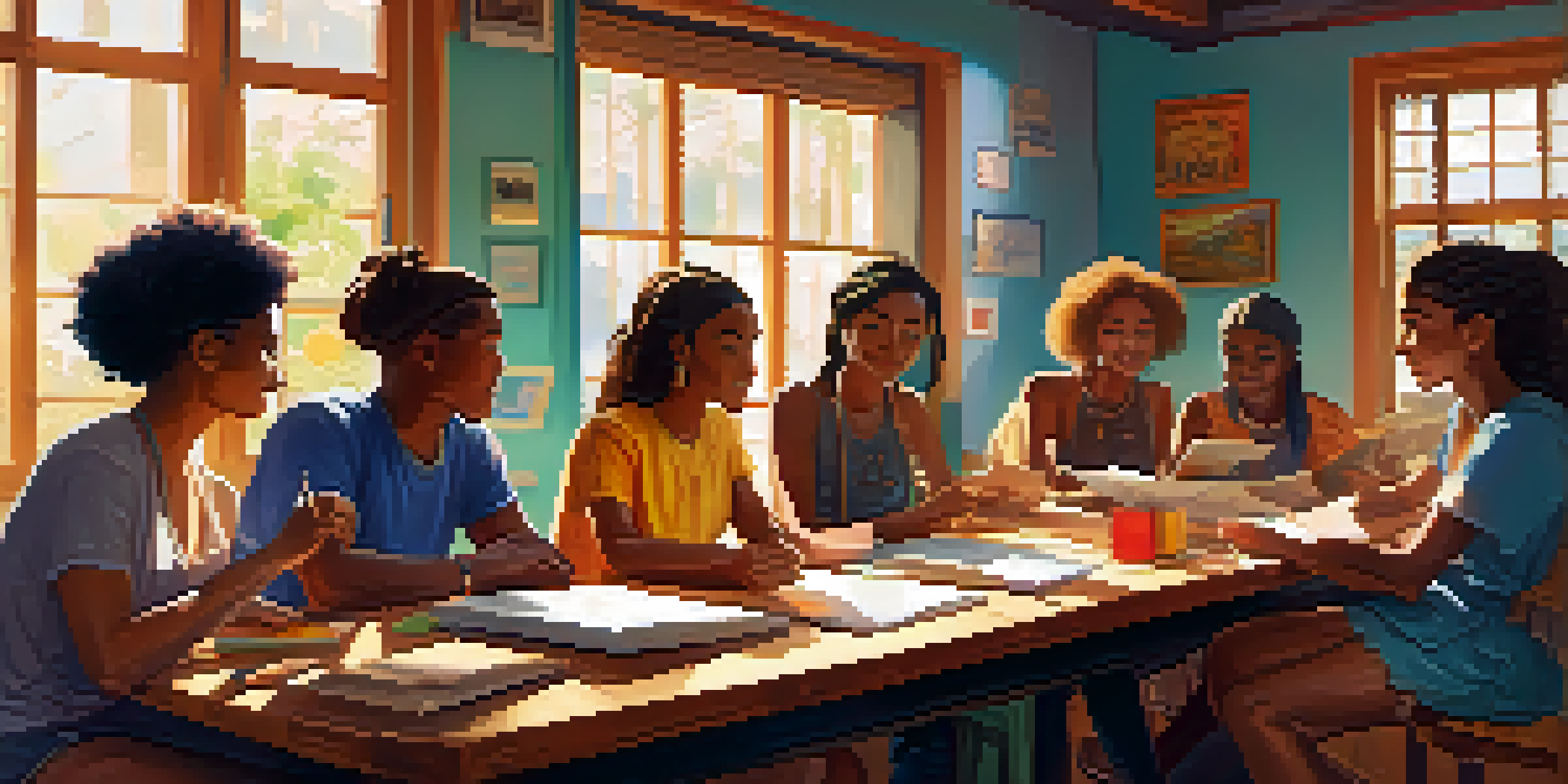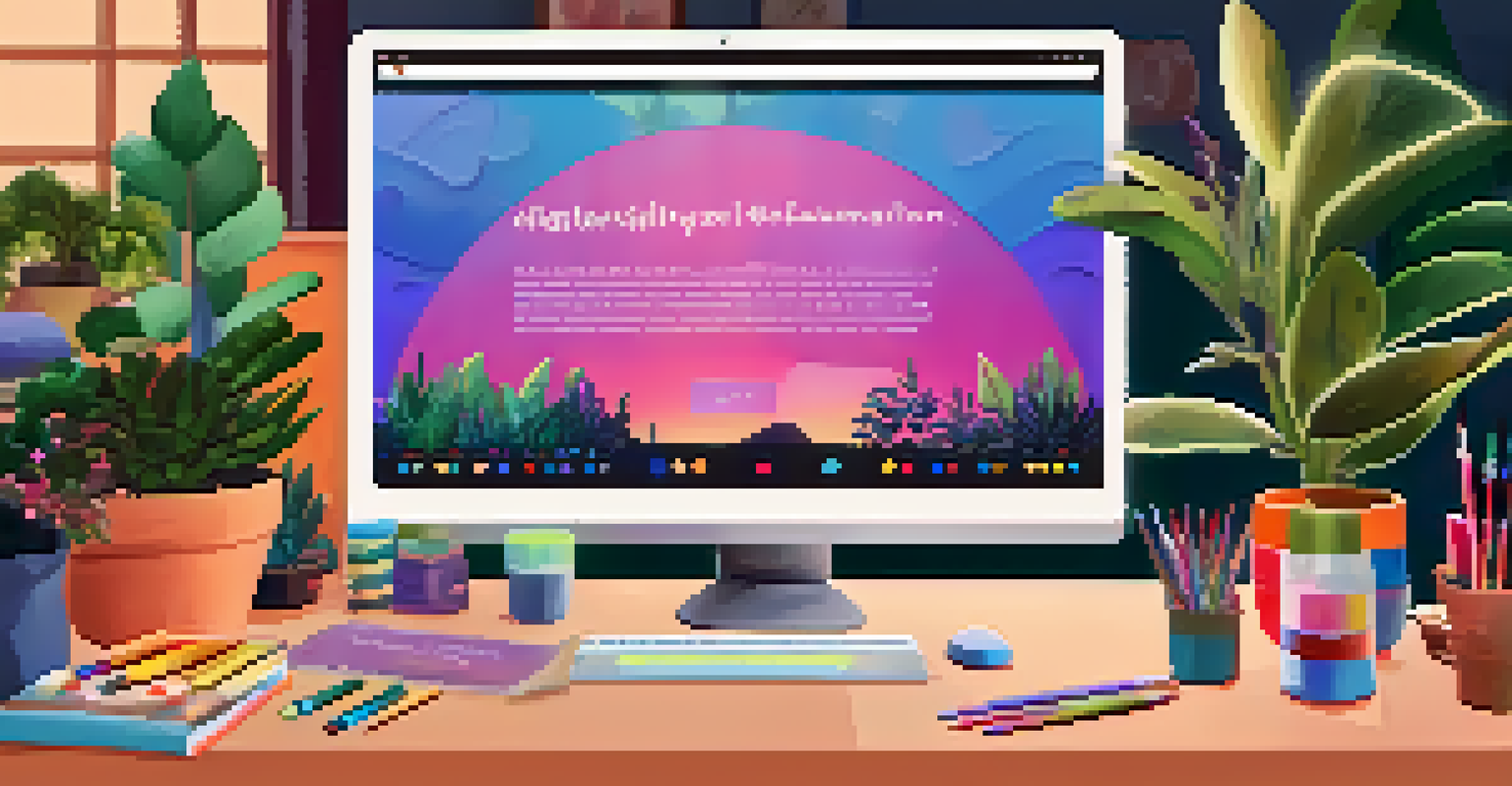Creating Collaborative Digital Stories with Online Tools

Understanding the Power of Collaborative Digital Storytelling
Collaborative digital storytelling merges creativity with technology, allowing multiple voices to contribute to a single narrative. This method not only enriches the story but also fosters teamwork and communication among participants. Imagine a group of friends crafting a story together—each person adds their unique twist, making the final piece more vibrant and engaging.
Storytelling is the most powerful way to put ideas into the world today.
With the rise of online tools, this collaborative process has become more accessible than ever. Anyone, regardless of their location, can join in and share their ideas in real-time. This democratization of storytelling empowers individuals to express themselves and create something meaningful together.
Furthermore, collaborative storytelling can be an effective educational tool. It encourages critical thinking, problem-solving, and creativity—skills that are essential in today's interconnected world. By working together, participants learn to appreciate diverse perspectives, which enhances their ability to communicate and collaborate in future projects.
Choosing the Right Online Tools for Your Story
Selecting the right tools is crucial to the success of your collaborative storytelling project. There are numerous platforms available, each offering unique features that cater to different storytelling styles. For example, tools like Google Docs allow for seamless text editing, while platforms like Storybird provide a more visual experience with artwork and illustrations.

Consider the needs of your group when choosing a tool. If your team prefers a more visual approach, platforms that integrate images and videos may be beneficial. Alternatively, if the focus is on writing, a straightforward text editor might suffice. The goal is to find a tool that enhances collaboration rather than complicates it.
Collaborative Storytelling Enhances Creativity
Bringing together diverse voices enriches narratives and fosters teamwork.
It's also important to think about user-friendliness. A tool that is easy to navigate will keep everyone engaged and motivated. A complicated interface can lead to frustration, so opt for tools that provide tutorials or have a supportive community to help with any questions that arise.
Setting Clear Objectives for Your Collaborative Story
Before diving into the storytelling process, it's essential to establish clear objectives. What message do you want to convey? Setting a purpose helps guide the narrative and ensures that all contributors are on the same page. For instance, if the goal is to raise awareness about a social issue, every part of the story should reflect that theme.
The art of storytelling is the art of sharing, and the stories we share can change the world.
Having defined objectives also aids in organizing the structure of the story. It allows team members to brainstorm ideas that align with the main goal, making the creative process smoother. Think of it as building a house—each room (or story component) should serve a specific function related to the overall design.
Moreover, setting objectives can enhance accountability among team members. When everyone understands their role and the story's purpose, it fosters a sense of ownership and pride in the final product. This shared responsibility can lead to deeper investment in the storytelling process.
Encouraging Participation and Inclusivity in Storytelling
An inclusive environment is vital for collaborative storytelling. It's important to encourage all participants to share their ideas without fear of judgment. Creating a safe space where everyone feels valued leads to richer narratives and a more enjoyable experience for all involved.
One way to promote inclusivity is by actively seeking input from quieter members of the group. Ask open-ended questions or assign specific roles, ensuring that everyone has an opportunity to contribute. This approach not only diversifies the story but also empowers all voices within the group.
Choosing the Right Tools Matters
Selecting user-friendly online platforms enhances collaboration and keeps participants engaged.
Additionally, acknowledging and respecting different perspectives enhances the storytelling experience. Encourage participants to draw from their personal experiences or cultural backgrounds, as this can add depth and authenticity to the narrative. By weaving together varied viewpoints, the story becomes a tapestry of shared human experiences.
Developing a Cohesive Narrative Together
As contributors share their ideas, it's crucial to weave these threads into a cohesive narrative. This process often involves discussion and collaboration to ensure that all elements align with the story's objectives. Think of it as a group puzzle—each piece must fit together to create a complete picture.
To facilitate this process, consider appointing a narrative leader or editor. This person can help guide discussions and ensure that everyone's contributions are integrated smoothly. They can also provide feedback, suggesting ways to enhance the narrative flow and maintain consistency throughout the story.
Regularly reviewing the story as it develops can help identify any gaps or inconsistencies. Encourage participants to reflect on the narrative as a whole and suggest adjustments as needed. This iterative process not only strengthens the story but also fosters a sense of collaboration and shared ownership among all contributors.
Incorporating Multimedia Elements for Engagement
Multimedia elements can significantly enhance the storytelling experience. Incorporating images, videos, or audio clips brings stories to life, making them more engaging for the audience. For example, a story about a community event could include photos from the event or video interviews with participants, adding depth and context.
Online tools often make it easy to integrate these elements into your collaborative project. Platforms like Canva or Adobe Spark allow users to create visually appealing graphics, while tools like Soundcloud can be used to embed audio clips. By using a mix of media, you can cater to different learning styles and keep your audience captivated.
Set Clear Goals for Effective Stories
Establishing clear objectives ensures all contributors align their ideas with the story's purpose.
However, it’s important to strike a balance. While multimedia can enhance a story, overloading it with too many elements can distract from the narrative. Aim for a harmonious blend that complements the storytelling rather than overwhelms it.
Sharing Your Collaborative Digital Story with the World
Once your digital story is complete, it's time to share it with a broader audience. This is an exciting moment for all contributors, as they get to showcase their hard work and creativity. Consider using social media platforms, blogs, or even video-sharing sites to distribute your story widely.
When sharing, be sure to highlight the collaborative nature of the project. This not only gives credit to all contributors but also emphasizes the power of teamwork in storytelling. Sharing behind-the-scenes insights or the challenges faced during the process can also resonate with your audience, making the story more relatable.

Lastly, encourage feedback from your audience. Engaging with viewers can provide valuable insights and foster a sense of community. It’s also a great way to learn what worked well and what could be improved for future collaborative storytelling projects.